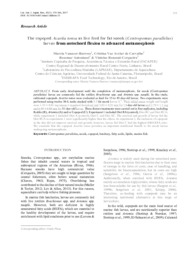The Copepod Acartia tonsa as live feed for fat snook (Centropomus parallelus) larvae from notochord flexion to advanced metamorphosis.
The Copepod Acartia tonsa as live feed for fat snook (Centropomus parallelus) larvae from notochord flexion to advanced metamorphosis.
Author(s): VANACOR-BARROSO, M.; CARVALHO, C. V. A. DE; ANTONIASSI, R.; RONZANI-CERQUEIRA, V.
Summary: From early development until the completion of metamorphosis, fat snook (Centropomus parallelus) larvae are commonly fed the rotifers Brachionus spp. and Artemia spp. nauplii. In this study, cultivated copepods Acartia tonsa were evaluated as feed for 15-to 45-day-old larvae. Two experiments were performed using twelve 30-L tanks stocked with 3.3 fat snook larvae L-1. Their initial mean weight and length were 1.35 ± 0.01 mg (mean ± standard deviation) and 3.83 ± 0.33 mm for 15-day-old larvae and 2.79 ± 1.2 mg and 6.99 ± 0.88 mm for 31-day-old larvae. Three dietary treatments were carried out in four replicates, including Rotifer (R), Artemia (A) and/or Copepod (C). Experiment 1 included Diet RA (control), Diet RC and Diet RCA; while experiment 2 included Diet A (control), Diet C and Diet AC. The survival and growth of larvae fed the Diet RCA in experiment 1 were significantly higher than the others. In experiment 2, the inclusion of copepods in the diet did not improve survival and growth, however, larvae fed Diet C had the highest DHA/EPA ratio. We conclude that the copepod Acartia tonsa provides an important nutritional benefit to fat snook larvae undergoing metamorphosis.
Publication year: 2017
Types of publication: Journal article
Unit: Embrapa Food Technology
Keywords: Centropomus parallelus, Copepod, Hatchery, Snook, fatty acids, lipids, marine fish
Observation
Some of Embrapa's publications are published as ePub files. To read them, use or download one of the following free software options to your computer or mobile device. Android: Google Play Books; IOS: iBooks; Windows and Linux: Calibre.
Access other publications
Access the Agricultural Research Database (BDPA) to consult Embrapa's full library collection and records.
Visit Embrapa Bookstore to purchase books and other publications sold by Embrapa.

